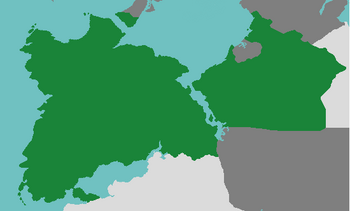Mesoland
United Communities of Mesoland Vereinigte Gemeinschaften Mesoland | |
|---|---|
|
Flag | |
| Motto: "We walk always, together always" | |
| Anthem: Rise, Mesoland, rise | |
 | |
| Capital and largest city | Tabarak |
| Official languages | English, German |
| Recognised national languages | Dutch, Mesozulu |
| Recognised regional languages | Nika, Hambatsu, Japanese, Korean |
| Ethnic groups | 31.76% Black 30.41% White (12.11% Germanic 8.15% Anglo 7.34% Afrikaner 2.81 Other) 27.92% Two or more races 7.74% Asian 0.48% Native Meso 1.69% Other |
| Demonym(s) | Meso |
| Government | Federal Parliamentary Republic |
| Alexander Harris | |
| Kechi Agbobo | |
| Nyara Lasengara | |
| Tyrus Roland Green | |
| Legislature | Federal Parliament |
| Establishment | |
| 1st June 1722 | |
| 15th January 1741 | |
| Area | |
• Total | 8,145,000 km2 (3,145,000 sq mi) |
• Water (%) | 1.3% |
| Population | |
• 2019 estimate | 276,242,954 |
• Density | 33.9/km2 (87.8/sq mi) |
| GDP (PPP) | 2019 estimate |
• Total | $7.773 trillion |
• Per capita | $33,950 |
| GDP (nominal) | 2019 estimate |
• Total | $7.159 trillion |
• Per capita | $32,000 |
| Gini | 33 medium |
| HDI | 0.871 very high |
| Currency | Mesoland Dollar (MZD) |
| Time zone | MST (Mesoland Standard Time) |
| Date format | dd-mm-yyyy AD |
| Driving side | left |
| Calling code | +28 |
| Internet TLD | .mz |
Mesoland, officially the United Communities of Mesoland or Vereinigte Gemeinschaften Mesoland is a large federal parliamentary republic in the east of Astyria. It comprises of 20 provinces and covers an area of 8,145,000 square kilometres (3,145,000 square miles) with a population of about 276 million inhabitants. Situated primarily on the continent of Ixalia, Mesoland is split into western and eastern parts separated at the narrowest point by a 30km stretch of water at the mouth of the Barrington Sea. Mesoland shares land borders with Zitru to the southeast, Nova Deseret to the northwest and San Joaquin Valley and Caprica to the northeast. Mesoland is a highly multicultural and multiracial country in which no majority race exists, hundreds of years of wide scale immigration from across the globe helping to create one of the most racially varied nations on the planet. Mesoland's capital and largest city is Tabarak, home to more than 33 million inhabitants within the city limits alone. Other major cities include Ilungwe, Foxburg, Union City and Port Rogan.
Fossil records indicate that Mesoland has been inhabited by humans for more than 30,000 years. Migration to Mesoland began as early as the 1st century AD with the first Afro settlers arriving from territories in the far east. A lengthy period of conflict then ensued between the indigenous Mesos and the settlers. Large scale Afro migration to Mesoland continued until around the 15th century around which time white settlers, mainly of Germanic, Dutch, Anglo, Gaelic and French descent, began to arrive in Mesoland, a trend that continued well into the 20th century.
For much of recent history, Mesoland was made up of a number of independent factions and kingdoms, often at war with one another over racial and territorial divisions. By 1450, however, a black majority kingdom, the Masha Kingdom, began to emerge as a dominant force in the region, spreading from its roots in the north west southwards and by the early 18th century ruling over the land comprising modern day Mesoland. Following the Meso succession crisis of 1722 and the subsequent collapse of the Masha dynasty, a republic was declared by The 1722 22, the name given to the 22 landowners and businessmen who reached across racial and tribal divides to attempt to form a democracy in response to the instability that gripped Mesoland following the collapse of the Masha rule, and Mesoland was founded on the 1st of June 1722. The early phase of the republic was marred with conflict and secession attempts as the first Meso government, with 10 of the 1722 22 in senior positions, refused to release its grip on power until 1740 when the first democratic elections were held in the wake of a successful coup led by 8 members of the 22 who had not been involved in the first government. From this point, Mesoland ushered in a period of industrialisation and great cultural and economic enlightenment, further immigration helping the economy to soar and allowing Mesoland to emerge from the 19th century as a great Astyrian military, economic and cultural force.
In the present day, Mesoland is a wealthy, highly developed nation with a high quality of life and high life expectancy. Mesoland ranks highly in various measures of prosperity including GDP per capita, production efficiency, transport efficiency and happiness. Tabarak is a global financial centre with over 200 international corporations headquartered in the city and an average wage in the top percentile of the world. Mesoland's largest economic sectors are services and information technology, although manufacturing and agriculture feature to a great extent. Mesoland has one of the highest military expenditures by percentage in Astyria at 4.2% and has a modern military comprising of upwards of 950,000 troops.
History
Indigenous People
It is not known when the first inhabitants of Ixalia arrived on the continent but it is generally accepted that the area of land that comprises modern-day Mesoland has been inhabited for at least 20,000 years. Although evidence of ancient settlement has been found across modern Mesoland, the majority of artefacts pertaining to ancient people have been found in the extreme west of the country, suggesting the people may have arrived on rudimentary boats or across a land bridge from the north or west. Evidence of tool use has been found dating back to 15,000 years ago, however some deep forest-dwelling groups are thought to not have developed advanced tool use until as early as 7,500 years ago.
Some small civilisations arose from pockets of indigenous Meso people, many of those living in plains regions developing advanced agriculture and architecture. The Iqajarriasott civilisation was especially prolific among indigenous societies, with much of their architecture from both sides of the year 1 AD still standing. Numerous national parks today exist primarily to protect ancient Meso architecture and sites.
First Settlement
By 100 AD, black explorers such as Sibusi Kipsele and Se Lokoa had started arriving on Ixalia from outside of Astyria and within 350 years, an estimated total of 1.2 million black settlers were resident in what is now Mesoland, mostly concentrated along the north west coast. After Asayah Yuturu and his mercenary army made their epic 800 mile foot crossing of the barren Great Carrick Desert in 440 AD, paving the way for settlement in the south of what is now Mesoland, the black population quickly spread from its heartland in the north west to encompass most of modern day Mesoland. Having spread across such a vast area, the previously mostly unified black population splintered and dozens of factions and small kingdoms emerged. This spread also led to violence previously unseen in the region, with indigenous groups and settlers seemingly abandoning their previously friendly relations and triggering a series of wars between settlers and other settlers and the indigenous people that would continue in one form or another for near enough the next millenia.
Meso Dark Ages
The years 800-1400 are known as the Meso Dark Ages. During this period, the area of land that was around this time coming to be known as Mesoland was comprised of a number of feudal states, each ruled by a king. Most of the states were hostile to one another and new kingdoms and fiefdoms would emerge and collapse often. Except along the north coast, especially in established settlements such as Tabarak, these kingdoms spent their entire existence at war with other settlers kingdoms or with indigenous people. The indigenous Meso people generally had inferior weaponry and technology to the settlers and by 1200 had been completely driven into the extreme west and east of Mesoland, with the last recognised advanced indigenous civilisation having been dismantled in 1183. Millions of indigenous people are thought to have been killed during the Dark Ages, with 500,000 estimated to have escaped to the forests of the far west or the mountains of the far east. Some 300,000 extremely deep forest-dwelling indigenous people, who remain to this day largely uncontacted, were uninvolved in Dark Age conflict.
Second Settlement
By 1400, 2 dominant kingdoms had emerged in Mesoland, the Masha Kingdom and the Shaka Kingdom.
Foundation and early democracy
Further immigration and industrialisation
Contemporary history
Geography, climate and environment
Demographics
Government and politics
Law enforcement and crime
Economy
Infrastructure
Education
Culture
Sports
Science and technology
Health

